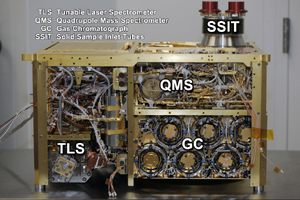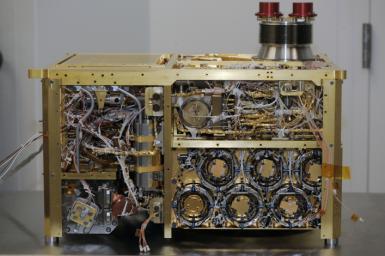
Annotated Version
Click on the image for larger versionAn instrument suite that will analyze the chemical ingredients in samples of Martian atmosphere, rocks and soil during the mission of NASA's Mars rover Curiosity, is shown here during assembly at NASA Goddard Space Flight Center, Greenbelt, Md., in 2010.
The Sample Analysis at Mars, or SAM, is about the size of a microwave oven. This image was taken before installation of its side panels and before environmental testing. The suite's three instruments are visible: the tunable laser spectrometer (TLS) at lower left, quadrupole mass spectrometer (QMS) at upper right, and gas chromatograph (GC) at lower right.
SAM's solid sample inlet tubes (SSIT), visible at top right, are the routes by which Curiosity's robotic arm will deliver samples of soil and powdered rock for analysis. Other major components of SAM include the sample manipulation system and the gas processing system. The gas processing system uses transfer lines, heaters, temperature sensors and turbomolecular pumps.
The tunable laser spectrometer uses absorption of light at specific wavelengths to measure concentrations of selected chemicals, such as methane, carbon dioxide and water vapor. It also identifies the proportions of different isotopes in those gases. Isotopes are variants of the same element with different atomic weights, and their ratios can provide clues about the planet's history.
The quadrupole mass spectrometer identifies gases by the molecular weight and electrical charge of their ionized states. It will check for several elements important for life as we know it, including carbon, nitrogen, sulfur and oxygen contained in volatile molecules.
The gas chromotograph separates different gases from a mixture to aid identification. It has its own detector but also feeds the separated fractions to the quadrupole mass spectrometer and the tunable laser spectrometer for more detailed analysis.
JPL manages the Mars Science Laboratory/Curiosity for NASA's Science Mission Directorate in Washington. The rover was designed, developed and assembled at JPL, a division of the California Institute of Technology in Pasadena.
For more about NASA's Curiosity mission, visit: http://www.jpl.nasa.gov/msl, http://www.nasa.gov/mars, and http://marsprogram.jpl.nasa.gov/msl.

 Planetary Data System
Planetary Data System













